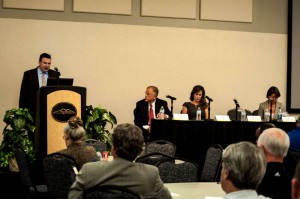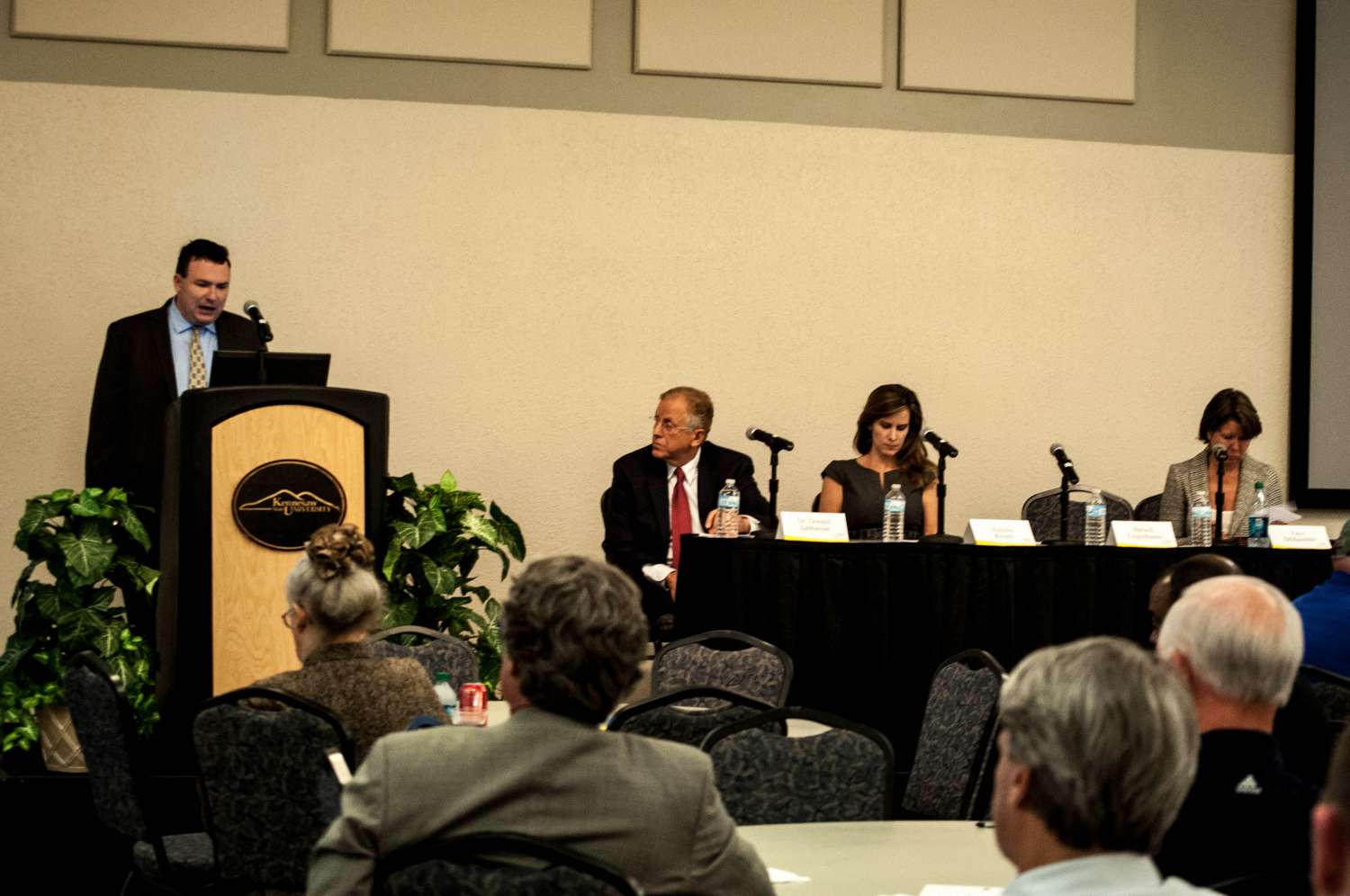By: Sierra Hubbard, Staff Writer
The fifth annual town hall forum hosted by the KSU Small Business Development Center and Econometric Center was held on Thursday, Sept. 18 in the KSU Center to discuss improvements to and answer questions concerning Cobb County transportation.
 Sponsored by Fontis Water, the panel was comprised of three experts in the field of transportation and moderated by Dr. Donald Sabbarese, former director of the Econometric Center. Topics discussed included partnerships to secure funding for community projects, ideas for further improving traffic conditions in the county, and current ventures such as the construction on Frey Road to bypass I-75.
Sponsored by Fontis Water, the panel was comprised of three experts in the field of transportation and moderated by Dr. Donald Sabbarese, former director of the Econometric Center. Topics discussed included partnerships to secure funding for community projects, ideas for further improving traffic conditions in the county, and current ventures such as the construction on Frey Road to bypass I-75.
“The Kennesaw State University SBDC is a cooperative program with [the] University of Georgia and the U.S. Small Business Administration to provide consulting and training for existing and would-be small business owners,” Drew Tonsmeire, director of the center, said. “The KSU SBDC has been of service for over 30 years in our community.”
This event was the fifth town hall forum held to cover relevant issues affecting the community. The first forum in 2009 covered the housing crisis at the time, and the following year focused on the failing banking industry. This year, the panel discussion answered residents’ questions about transportation in Cobb County and impending improvements that will take effect within the next few years.
There are “three big factors” affecting transportation in Cobb County, Tonsmeire said. “One is that KSU has really grown into its own. It will continue to grow.” The second is that, “ten miles up the road, one of the largest youth sports complexes is being built. It’s called LakePoint. When it’s completed, there will be over a million people going in and out of that facility, most of them driving. So they are coming up and down I-75,” he said. The last factor is the move and construction of the Braves stadium, which will definitely have a monumental impact on traffic conditions in the area.
“That’s what we want to do with our panel discussion,” Tonsmeire said, “is have a logical discussion of what’s going on and how do we handle that.”
The first panelist was Malaika Rivers, executive director of the Cumberland Community Improvement District.
“I represent the business community in this side of things,” Rivers said.
The Cumberland Community Improvement District was Georgia’s first Community Improvement District (CID). According to Rivers, when all legislation is approved and a majority of the commercial property owners in a district vote and agree to the terms of the CID, additional property taxes are applied. As stated on the company’s website, “Cobb County collects the taxes and distributes those funds to the CID.”
“If you’re a commercial owner,” Rivers said, “and you have invested $50 [million] or $100 million in your building, you want to make sure that people can get to that building. So it is absolutely critical for economic development purposes.”
The concept of the CID is to leverage funds to initiate the beginning phases of infrastructure projects in a community. This accelerates the process of completing these same projects when more funds become available from the government.
“It’s a tax, but it’s only paid by commercial property owners. So it’s not a sales tax, it’s not a residential tax,” Rivers said, adding that the business owners are contributing to a public good for their community. “If we widen a road, if we build a sidewalk, then clearly anybody can use it.”
Rivers’ presentation focused on developments that have been pushed through since 1988 in the Cumberland area and the benefits of a partnership like this for Cobb County.
While Rivers showed proven examples from the past, the second panelist, Baruch Feigenbaum, redirected the crowd’s attention to theories and ideas for improving the future. Feigenbaum is a transportation policy analyst for the Reason Foundation, a nonprofit organization that concentrates on advancing free minds and free markets.
His presentation addressed the troubling statistics regarding the commute times of average residents in the county. “Only 3.6 percent of jobs are accessible by transit in 45 minutes,” Feigenbaum said. “But, in Cobb County, that’s actually closer to about 1 percent.”
To confront these issues, he offered many solutions, both short-term and long-term, that can be applied in the coming years as funding comes available.
“I am a big fan of a user-pay/user-benefit system, which means we’re actually spending gas tax on transportation needs,” Feigenbaum said. “[With] the current sales tax on gasoline, only 3 cents are spent on transportation.”
This user-pay/user-benefit system also encompasses features like overpasses that would charge a small fee to drivers who choose to take this route to avoid congestion on interstates like I-75.
“You’re looking for other ways to get over 75,” Feigenbaum said. “You’re probably going to be looking for some slower-speed streets where you can do bicycling along the street and walking on the sidewalk – those are things you would get on a more community-oriented road.
“It’s a matter of parallel streets and local streets that accommodate all uses – cars, buses, bikes, walkers.”
Many of these are concepts are still in the development stages and would ideally be implemented as funds allow in years to come.
To tie the forum discussion together, Faye DiMassimo, the director of the Cobb County Department of Transportation, presented and elaborated on projects that are currently underway.
“The transportation business is a partnership business,” DiMassimo said. “It will continue to be a partnership business moving forward.”
She was able to shed light on the many successful measures the DOT has taken to both reduce traffic in the area as well as increase safety of drivers on the road. She explained the use of fiber optic technology and video surveillance to better communicate traffic conditions and respond quickly. DiMassimo then elaborated on the Skip Spann connector, the bridge over I-75 between Busbee Drive and Frey Road. According to DiMassimo, this development will reduce traffic congestion on Chastain Road by 19 percent and is scheduled to be complete in March of 2016.
“There’s a lighted design on the bridge that mimics the outline of the Kennesaw mountain in the background,” she said, explaining the art project that was a collaboration of college students from several universities.
DiMassimo also covered a few topics that are still in the conceptual stage. The first was the creation of an Aviation Management Program at KSU in the future, which would incorporate the McCollum Airport facilities. Another topic briefly mentioned was the development of a bus route that would connect several universities between KSU and Atlanta together along one route.
Her main point, however, was stressing the importance of cooperation within the community.
“One of the things we have absolutely got to do is work together to utilize every kind of transportation tool we’ve got, which also means transit,” DiMassimo said. “We don’t have all the answers, but we absolutely have the best people, I think, and the resources that we need to be able to come together and figure out what the answers are to those questions.”



